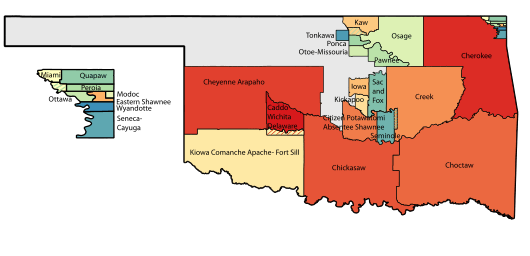Oklahoma Tribal Statistical Area facts for kids
An Oklahoma Tribal Statistical Area (OTSA) is a special area in Oklahoma that helps the U.S. Census Bureau count people. These areas are chosen and described by Native American tribes that the government officially recognizes.
Many of these areas are also called Tribal Jurisdictional Areas. This means the tribes in these areas can offer government services and have authority over their members.
These areas are a bit different from regular reservations. In Oklahoma, land was often divided up a long time ago. So, people living in an OTSA can be both Native American and non-Native American. Only tribal members living there follow the tribe's government rules.
Five of these areas are very important. They belong to the Five Civilized Tribes (Cherokee, Choctaw, Chickasaw, Creek, and Seminole). These five areas cover almost half of Oklahoma, including big cities like Tulsa. The U.S. government officially recognizes these five areas as reservations through old treaties. This means that for tribal members, these areas are not under Oklahoma state law.
Contents
Tribal Areas in Oklahoma
Here is a list of the different Oklahoma Tribal Statistical Areas.
The Five Tribes (Reservations)
These five tribes have areas that are officially recognized as reservations by federal treaties.
Other Tribal Statistical Areas
These are other important OTSAs in Oklahoma:
- Caddo-Wichita-Delaware OTSA
- Cheyenne-Arapaho OTSA
- Citizen Potawatomi Nation-Absentee Shawnee OTSA
- Eastern Shawnee OTSA
- Iowa OTSA
- Kaw OTSA
- Kickapoo OTSA
- Kiowa-Comanche-Apache-Fort Sill Apache OTSA
- Miami OTSA
- Modoc OTSA
- Otoe-Missouria OTSA
- Ottawa OTSA
- Pawnee OTSA
- Peoria OTSA
- Ponca OTSA
- Quapaw OTSA
- Sac and Fox OTSA
- Seneca-Cayuga OTSA
- Tonkawa OTSA
- Wyandotte OTSA
Joint Use Areas
Sometimes, different tribes share areas for certain purposes. These are called Joint Use Areas (JUAs) within the OTSAs:
- Creek–Seminole JUA OTSA
- Kaw–Ponca JUA OTSA
- Kiowa–Comanche–Apache–Fort Sill–Caddo–Wichita–Delaware JUA OTSA
- Miami–Peoria JUA OTSA


